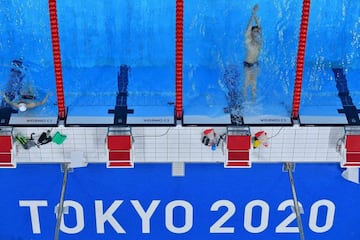OLYMPIC GAMES
Olympic swimming pool: How deep, cold, and long is it and how many gallons does it hold?
Olympic swimming pools are deeper, colder, and longer than you might assume. Certain requirements exist to protect the athletes and allow them to perform at the highest level.

Olympic pools are much deeper than you might assume. The Olympic Committee requires a minimum depth of two meters. This is to protect the swimmers from waves that might form if a pool were shallow. If you have ever been swimming in an ocean, you know that rough waters are much more difficult to swim in and they slow you down. The Olympics required deep pools to avoid the hazard and to increase the swimmers' performance.
According to Teri McKeever, the head coach of the University of California's women's swimming team and the prior swim coach at the 2012 London Olympics, "A fast pool typically has at least three meters of depth to it. The deeper the pool is the better, because the splash or the turbulence and everything takes longer to get down to the bottom and then it doesn't ricochet back up into the swimmers."

How long are Olympic swimming pools?
FINA, the international federation recognised by the International Olympic Committee, is extremely strict on its measurements. Whereas a standard swimming lap pool is typically about 22.8 meters or 25 yards, an Olympic swimming pool is 50 meters, which holds 490,000 gallons of water.
How cold are Olympic swimming pools?
There's strategy involved in everything to create circumstances for top performance, and that extends to the temperature of the swimming pool. Olympic swimming pools are required to be between 25-28° celsius, which is between 77° and 82.4° fahrenheit. For reference, public pools are typically set between 78°and 88° fahrenheit. This temperature allows for swimmers to keep muscles warm enough, while ensuring swimmers don't experience dehydration, muscle cramps or overheating.
A pool set at a temperature too cold or too warm can be very dangerous, causing overheating when too warm or the potential of cardiac arrest when too cold. Further, a pool may initially feel freezing once you jump into the water, but once you get your body moving, the temperature feels bearable. This is comparable to the outside temperature when you go for a run.
Where are the Tokyo swimming events held?
Tokyo Aquatics Centre has been newly constructed in the Tatsumi-no-Mori Seaside Park. Following the 2020 Games, the venue will host domestic and international competitions.






